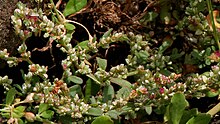| Polygonum plebeium | |
|---|---|
 | |
| Scientific classification | |
| Kingdom: | Plantae |
| Clade: | Tracheophytes |
| Clade: | Angiosperms |
| Clade: | Eudicots |
| Order: | Caryophyllales |
| Family: | Polygonaceae |
| Genus: | Polygonum |
| Species: | P. plebeium |
| Binomial name | |
| Polygonum plebeium | |
Polygonum plebeium, (common name - common knotweed), [2] is a species of flowering plant in the knotweed family, first described in 1810 by Robert Brown from a specimen collected in Port Jackson, Australia. [3] [4]
